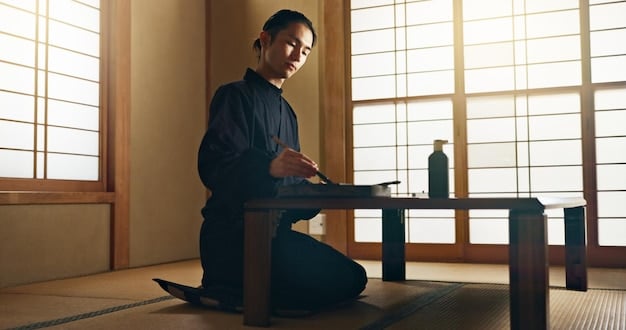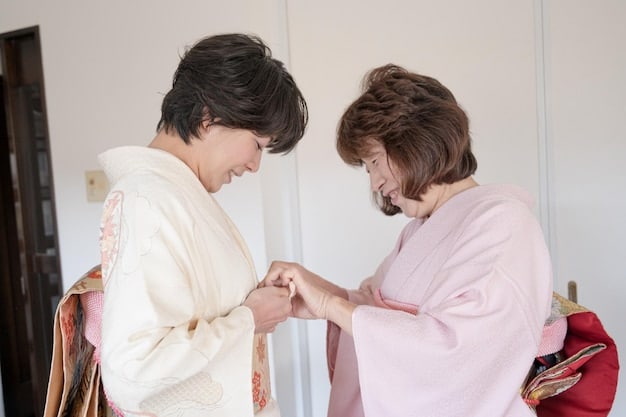Mastering the Art of Apology in Japan: A Cultural Guide

The art of apology in Japan is a deeply ingrained cultural practice that emphasizes sincerity, humility, and a profound understanding of social harmony, utilizing specific phrases and rituals to convey remorse and restore relationships.
In Japan, apologizing goes far beyond simply saying “I’m sorry.” The **art of apology in Japan** is a nuanced and complex social ritual, steeped in tradition and designed to restore harmony and maintain social order. Understanding these customs is crucial for anyone interacting with Japanese culture, whether personally or professionally.
Understanding the Cultural Significance of Apologies in Japan
Apologies in Japan carry a weight that often exceeds their literal meaning. They are not just about admitting fault; they are about acknowledging the disruption caused and expressing a commitment to rectifying the situation. The concept of “wa,” or harmony, is central to Japanese society, and apologies play a vital role in preserving it.
The depth of an apology is often dictated by the severity of the offense and the relationship between the individuals involved. Formal apologies involve specific language and actions that demonstrate a high level of remorse and respect. Informal apologies, while less elaborate, still require sincerity and an understanding of the social context.
The Concept of “Wa” and Its Impact on Apologies
“Wa” is the Japanese principle of harmony, and it is the driving motivation behind most social interactions. Maintaining “wa” and avoiding conflict are paramount to Japanese culture.
Apologies are used to heal any kind of perceived disruption to this balance. A quick and sincere apology can prevent misunderstandings from escalating into serious conflicts. It can also demonstrate one’s respect for another person or group.
In Japanese business culture, companies often issue profound apologies for problems with their products or services to demonstrate that they are prioritizing their customers’ happiness.
- Maintaining Harmony: Apologies preserve social equilibrium.
- Preventing Conflict: They preempt escalation of misunderstandings.
- Demonstrating Respect: Showing consideration for others’ feelings.

By understanding the cultural significance of apologies, foreigners can better navigate social situations and avoid causing unintended offense. It’s not just about saying the right words, but also about conveying the right attitude and understanding the underlying cultural values.
Key Phrases for Apologizing in Japanese
Knowing the appropriate phrases is crucial for delivering a sincere apology in Japan. The specific phrase used depends on the situation’s formality and the severity of the offense. From everyday apologies to formal acknowledgments of wrongdoing, the language used reflects the depth of remorse and the commitment to making amends.
Using the wrong phrase can undermine the sincerity of your apology and potentially cause further offense. Therefore, taking the time to learn and understand the nuances of Japanese apology language is essential for effective communication and maintaining positive relationships.
Common Apology Phrases and Their Nuances
There are different levels of formality to consider when determining the right phrase to use when apologizing. Let’s take a look at some of the most common:
Sumimasen (すみません): This is the most versatile and commonly used apology phrase. It can be used in a wide range of situations, from bumping into someone on the street to being late for an appointment. It conveys a general sense of apology and can also be used to express gratitude or ask for assistance.
Gomen nasai (ごめんなさい): This phrase is slightly more direct than “sumimasen” and is often used for more personal apologies. It implies a greater sense of responsibility and is suitable for apologizing to friends, family, or close colleagues.
Formal Apologies: When and How to Use Them
Formal apology phrases are used in very specific situations where you have made a major error. These are reserved for times when you truly must apologize and are not acceptable to use regularly:
Moushiwake gozaimasen (申し訳ございません): This is a very formal apology phrase used in business settings or when addressing superiors. It expresses deep remorse and acknowledges a significant offense. It is often accompanied by a bow, demonstrating respect and sincerity.
Makoto ni moushiwake gozaimasen (誠に申し訳ございません): This is an even more formal version of “moushiwake gozaimasen,” used for the most serious offenses. It conveys the utmost sincerity and regret and is often reserved for situations where one has caused significant harm or damage.
- Choose Wisely: Select phrases that match the situation’s formality.
- Practice Pronunciation: Clear delivery enhances sincerity.
- Be Mindful of Context: Understand the appropriate scenarios for each phrase.

The key to using these phrases effectively is to understand their context and deliver them with sincerity. Japanese culture places a high value on honesty and humility, so an apology must come across as genuine to be well-received.
The Art of Bowing: Ojigi in Apology
The bow, or ojigi, is an intrinsic part of Japanese communication, especially when apologizing. The depth and duration of the bow convey the level of remorse and respect. Understanding the different types of bows and their appropriate usage is essential for delivering a sincere and culturally appropriate apology.
Bowing is not just a physical gesture; it’s a visual representation of humility and respect. It’s a way to show that you are subordinate to the person you are apologizing to and that you acknowledge their position and feelings. A well-executed bow can significantly enhance the sincerity of your apology.
Types of Bows and Their Meanings
There are several kinds of bowing in Japanese culture. The angle of the bow matters as well as the duration, as these determine the kind of apology being offered:
Casual Bow (Eshaku): Approximately 15 degrees, primarily used for greetings and showing respect to equals or those of slightly higher status.
Respectful Bow (Keirei): Around 30 degrees, used in business situations to show respect to clients or superiors.
Deep Bow (Saikeirei): A 45-degree bow, reserved for expressing deep apologies or gratitude. Often held for several seconds to emphasize sincerity.
When apologizing, the depth and duration of the bow should reflect the severity of the offense. For minor offenses, a slight bow may suffice, while more serious offenses require a deeper and longer bow. It’s also important to maintain eye contact briefly before and after the bow to convey sincerity and attentiveness.
The Importance of Body Language
When bowing, your hands will either be at your sides or folded in front of you. You will also want to maintain a straight, respectful spine, as slouching can imply a lack of sincerity. You can also verbalize your apology while bowing.
Furthermore, the context in which you are apologizing can affect your nonverbal cues. For example, if you’re apologizing to the customer, you will make eye contact more often than if you’re apologizing to a family member.
- Practice Makes Perfect: Familiarize yourself with various bow types.
- Mirror the Context: Ensure your bow matches the situation.
- Maintain Posture: Convey respect through physical presence.
Mastering the art of bowing is crucial for demonstrating genuine remorse and respect in Japanese apologies. It’s a visual cue that complements the verbal apology, enhancing its sincerity and effectiveness.
Giving Gifts as a Gesture of Apology
In some situations, a verbal apology may not be enough to fully express remorse and restore harmony. In such cases, giving a gift, known as “owabi no shirushi,” can be an effective way to demonstrate sincerity and a commitment to making amends. The gift serves as a tangible expression of regret and a desire to repair the relationship.
Selecting the right gift requires careful consideration of the recipient’s preferences, the severity of the offense, and the social context. The gift should be thoughtful and appropriate, reflecting the giver’s genuine remorse and desire to make amends.
Selecting the Right “Owabi no Shirushi”
The gift itself is important and has to be culturally appropriate. Avoid strong-smelling items like perfumes as well as anything that can be construed as boastful or prideful.
Traditional gifts like high-quality sweets or food items are often acceptable. Consider the recipient’s tastes and preferences and make sure that the gift itself is wrapped tastefully.
Also, consider the price of the gift, as a gift that is too inexpensive can seem insincere.
The Proper Way to Present the Gift
When you are handing off the gift, be sure to present it with both hands while expressing your sincere apology. Your body language should emphasize contrition and your posture should be formal.
It is also important to hand off the gift in private and never in front of other people who may feel excluded or slighted by the gesture. Doing so could undo the positive impact of the apology.
- Choose Appropriately: Select gifts suitable to the context.
- Present Respectfully: Use both hands, display sincerity.
- Consider Wrapping: Tasteful presentation matters significantly.
By carefully selecting and presenting a gift as a gesture of apology, one can demonstrate a deep commitment to repairing relationships and restoring harmony. It’s a tangible way to show remorse and a willingness to make amends, further solidifying the sincerity of the apology.
What Not to Do When Apologizing in Japan
Just as important as knowing what to do when apologizing in Japan is understanding what not to do. Certain behaviors and phrases can undermine the sincerity of your apology and potentially cause further offense. Avoiding these pitfalls is crucial for delivering an effective and culturally appropriate apology.
Japanese culture places a high value on humility, sincerity, and respect. Any behavior that contradicts these values can detract from the apology and damage the relationship. By being mindful of these potential missteps, you can ensure that your apology is well-received and achieves its intended purpose.
Common Mistakes to Avoid
One of the most common mistakes is failing to take responsibility. It’s important to avoid shifting blame, making excuses, or downplaying the severity of the offense. A sincere apology requires acknowledging your role in the situation and accepting responsibility for your actions.
Additionally, insincere body language, such as avoiding eye contact, slouching, or speaking in a dismissive tone, can undermine the apology. Maintaining a respectful posture and speaking with humility and sincerity are essential for conveying genuine remorse.
Also, it should be noted that being overly emotional may be counterproductive. While expressing sincere remorse is vital, excessive displays of emotion can be seen as insincere or performative. It’s best to maintain a composed and respectful demeanor while expressing your regret.
The Significance of Sincerity and Humility
Sincerity and humility are important aspects in an apology and are valued highly in Japanese culture. Showing concern for the other person’s feelings can go a long way in gaining their trust.
It’s imperative to take responsibility for your actions and display a genuine understanding of how they have affected others.
- Take Responsibility: Avoid blaming others.
- Be Genuine: Display authentic regret.
- Show Humility: Recognize the impact of your actions.
By being aware of these common mistakes and focusing on sincerity, humility, and respect, you can avoid undermining your apology and ensure that it is well-received. A thoughtful and culturally appropriate apology can go a long way in repairing relationships and restoring harmony.
Apologies in Japanese Business Culture
In Japanese business culture, apologies are a critical component of maintaining relationships and ensuring smooth operations. They are used not only to address mistakes but also to express empathy and build trust. Understanding the nuances of apologies in this context is essential for anyone conducting business in Japan.
Apologies in business settings are often more formal and structured than personal apologies. They may involve specific language, actions, and even public statements, depending on the severity of the situation. Transparency and accountability are highly valued, and apologies are seen as a reflection of a company’s commitment to these principles.
The Role of Apologies in Maintaining Business Relationships
One of the most important roles of apologizing during business is maintaining the client relationship with the other business. This way, the client knows that you have their best interests at heart.
This also shows a business’ transparency as well as a cultural awareness that may be greatly appreciated by the client, especially if they are also Japanese. Furthermore, apologies can reduce the amount of damage from potential disputes.
When and How to Issue a Public Apology
When the infraction affects not only an individual client, but the public at large, it’s important to take steps to conduct a public apology. This reinforces your business’ transparency.
Keep it respectful by using formal language to show how much you value your customers’ well-being. Public apologies may be delivered in person, or through a written announcement. Either way, it is essential to take responsibility.
- Promote Transparency: Disclose issues openly.
- Value Relationships: Show care for business partners.
- Reduce Disputes: Prevent conflicts through proactive apologies.
| Key Element | Brief Description |
|---|---|
| 🙇 Sincerity | Essential for apologies to be well-received. |
| 🗣️ Correct Phrases | Using appropriate language for the specific situation. |
| 🎁 Gift-Giving | A tangible way to show remorse and commitment. |
| 🤝 Relationship | Prioritizing harmony and repairing relationships. |
Frequently Asked Questions
The most common way to apologize in Japan is to say “sumimasen,” a versatile phrase used in many situations, from minor inconveniences to expressing gratitude. It is a polite and widely accepted way to acknowledge an oversight.
Formal apologies should be used for significant offenses, especially in business settings or when addressing superiors. Phrases like “moushiwake gozaimasen” convey deep remorse and respect, indicating a serious acknowledgment of wrongdoing.
Bowing is highly important in Japanese culture, particularly when apologizing. The depth and duration of the bow reflect the level of remorse and respect. A deeper bow indicates a more sincere apology.
Yes, giving a gift, known as “owabi no shirushi,” can be an effective way to demonstrate sincerity and a commitment to making amends, serving as a tangible expression of regret and willingness to repair relationships.
Avoid making excuses, shifting blame, or downplaying the offense. Sincerity, humility, and taking responsibility are essential. Insincere body language, such as avoiding eye contact, can also undermine your apology.
Conclusion
Mastering the art of apology in Japan requires a deep understanding of cultural values, appropriate language, and respectful gestures. By internalizing these principles, one can effectively navigate social and professional situations, repair relationships, and foster harmony. The key lies in sincerity, humility, and a genuine commitment to making amends for any wrongdoing.





